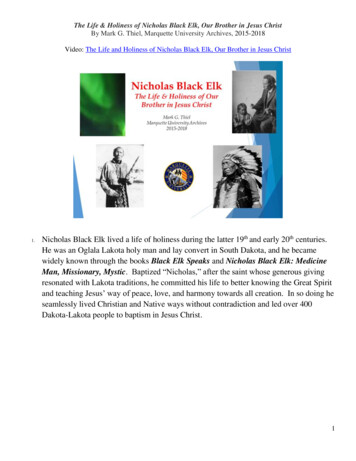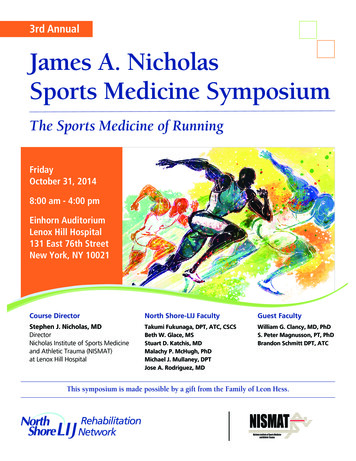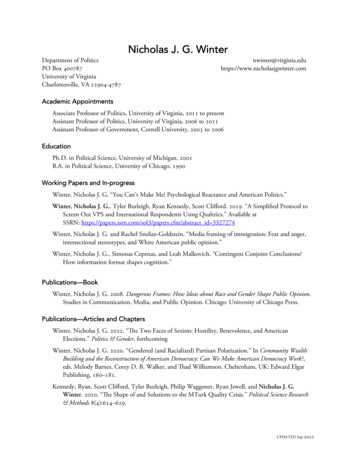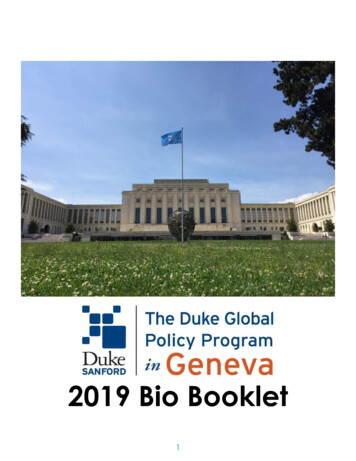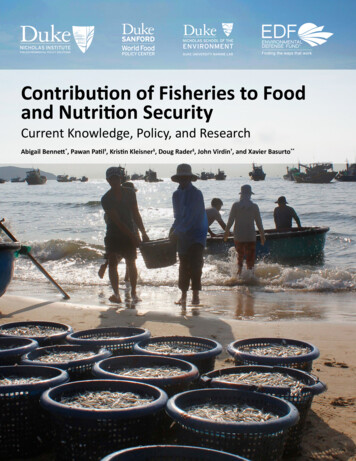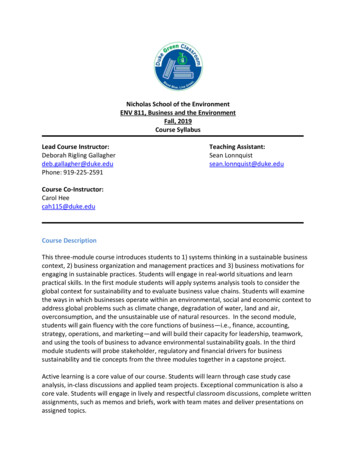
Transcription
Nicholas School of the EnvironmentENV 811, Business and the EnvironmentFall, 2019Course SyllabusLead Course Instructor:Deborah Rigling Gallagherdeb.gallagher@duke.eduPhone: 919-225-2591Teaching Assistant:Sean Lonnquistsean.lonnquist@duke.eduCourse Co-Instructor:Carol Heecah115@duke.eduCourse DescriptionThis three-module course introduces students to 1) systems thinking in a sustainable businesscontext, 2) business organization and management practices and 3) business motivations forengaging in sustainable practices. Students will engage in real-world situations and learnpractical skills. In the first module students will apply systems analysis tools to consider theglobal context for sustainability and to evaluate business value chains. Students will examinethe ways in which businesses operate within an environmental, social and economic context toaddress global problems such as climate change, degradation of water, land and air,overconsumption, and the unsustainable use of natural resources. In the second module,students will gain fluency with the core functions of business—i.e., finance, accounting,strategy, operations, and marketing—and will build their capacity for leadership, teamwork,and using the tools of business to advance environmental sustainability goals. In the thirdmodule students will probe stakeholder, regulatory and financial drivers for businesssustainability and tie concepts from the three modules together in a capstone project.Active learning is a core value of our course. Students will learn through case study caseanalysis, in-class discussions and applied team projects. Exceptional communication is also acore vale. Students will engage in lively and respectful classroom discussions, complete writtenassignments, such as memos and briefs, work with team mates and deliver presentations onassigned topics.
Our goal is for students to develop a holistic view of business interactions with the environmentso that they can be prepared to develop managerially, financially and technically sustainablesolutions to problems in private sector, corporate, NGO, and public agency settings.Course Materials:1. Readings and cases provided electronically on Sakai and in CoursepackSummary of graded work:Module 1: (Gallagher) Presentation: Student teams will deliver a presentation, which uses systems analysis toconfront a sector-based sustainability challenge. (10%) Participation: Students are expected to attend class and participate in class discussions(5%)For Module 2: (Hee) Decision Memo (TNT case study) – September 16th, 3pm (10%) Financial Statement Review—entries on Google sheet by Sept. 25th, 3pm (5%) Informational Memo (Non-Financial Reporting) —October 2nd, 3pm (10%) Everest Simulation—October 18th, Midnight (11:59am) (10%) Decision Memo (Green Marketing – Method/LUSH Cosmetics)—October 23th, 3pm(10%) Participation: Students are expected to attend class and participate in class discussions(5%)Module 3: (Gallagher) Case Analysis: Student teams will apply the Learning Through Cases framework toconsider issues in two cases, Mining in Madagascar and First Solar (5% each) Memo: Students will write a decision memo and summary e-mail recommending acourse of action to decision makers at Clorox (10%) Presentation: Student teams will deliver a presentation on “sustainability as strategy”(15%) Participation: Students are expected to attend class and participate in class discussions(5%)A Note on Late Assignments If you have a good reason for not being able to turn in anassignment on time, it will be considered, if you speak to Deb or Carol beforehand. Otherwise,your grade will be adjusted downward appropriately for each day late.
Honor CodeTO UPHOLD THE DUKE COMMUNITY STANDARD: I will not lie, cheat, or steal in my academic endeavors; I will conduct myself responsibly in all my endeavors; and I will act if the Standard is compromised.Module I: What is sustainability and why should businesses care? [Deb Gallagher]A three-week module that introduces systems thinking and strategy as frames for howbusinesses approach sustainability, covering the following topics:1. Communication2. Sustainability as a Strategic Objective3. Systems Thinking and SustainabilityI-1. August 26. Introduction to Course, Learning through CasesRead: The Comprehensive Case for Sustainability Sustainability Lessons from the Front LinesWatch: Learning With Cases: An Interactive Study GuideAssignments: Familiarize yourself with syllabus, course Sakai site Purchase Course PackI-2. August 28. Strategy and Systems, Communicating: Memos, E-mails, Presentations, TeamIntroductions. Discussion and In-Class ExerciseRead Strategic Perspectives of Corporate Sustainability Management The Dawn of Systems Leadership Baumgartner and Rauter, 2017. Strategic Perspectives of Sustainability Memo Writing Supplemental Resources How to write e-mails that pass the 10-second testWatch: Video 1: How to Write a Memo [Nicki Cagle, Director of the Writing Studio]In-class assignment: The 10-second e-mailI-3. September 2. Sketching Systems for Change 1 (Business Level), Discussion and In-ClassExerciseRead Whole Systems Design: Introduction to Lifecycle Thinking Introduction to Systems Thinking
Guidelines for Drawing Causal Loop DiagramsWatch Got a Wicked Problem? First Tell Me How to Make Toast,https://www.ted.com/talks/tom wujec got a wicked problem first tell me how youmake toastIn-Class Assignment Introduction to Team Assignment, Sketching a Value ChainI-4. September 4. Sketching Systems for Change 2 (Planetary Level), Discussion and In-ClassExerciseRead: Steward, T. 2012 A Brief Introduction to the Multi-Level Perspective (MLP)Watch: What is MLP? Multi-Level Perspective https://vimeo.com/54338623 Sally Uren on System Change for Sustainability (GreenBiz 2019)https://www.youtube.com/watch?v 70zdK0eb7mUIn-Class Assignment: Multi-Level Perspective applied to your organizationI-5. September 9. Case Discussion: Eileen Fisher, Team Work Time (as possible)Read: Building a Sustainable Company: The Story of Eileen FisherConsider: What measures did Eileen Fisher take to reduce its environmental footprint? Did thecompany go far enough? How did the company promote sustainability? Consider the fashion industry sector from a system perspective. What are the benefitsof upcycling? How ca Eileen Fisher promote systems change?Assignment (ungraded, but checked) Complete the Learning Through Cases Analysis for Eileen Fisher (individually)In-Class Assignment: Work on Team Presentations (as time permits)I-6. September 11. Systems Analysis PresentationsAssignment: Team Presentations
Module II: Business Management – How Do Businesses Work and Why Should We Care?[Carol Hee]Through this course module, students will gain familiarity with the core functions of business.An understanding of the basic tenants of finance, accounting, strategic management,operations, and marketing will enable students to leverage their knowledge of environmentalsustainability issues in engagements with organizational leaders and with diverse stakeholdersso that environmental concerns are addressed in at all levels of decision-making.II-1. September 18. Introduction to Business Leadership and the Everest Simulation —“Never doubt that a small group of thoughtful, committed, citizens can change the world.Indeed, it is the only thing that ever has.” (Margaret Mead)Web Assignment: Take the approximately 15-minute long personality assessment available -test. Read and reflect on your results, paying particular attention to the following sections:Introduction, Strengths & Weaknesses, Career paths, and Workplace Habits. (Seeassignment description below.)Read: “Leadership and Intelligence.” James G. Clawson (2001). UVA Darden School ofBusiness. UVA-OB-0652. “Leading Change.” James G. Clawson (2001). UVA Darden School of Business. UVA-OB0648. “Buy-In.” James G. Clawson (2007). UVA Darden School of Business. UVA-OB-0924. “Conflict Management in Teams.” Kristin Behfar (2015). UVA Darden School ofBusiness. UVA-OB-1072. “TNT: Sustainable Enterprise for the 21st Century.” Carol Hee and Peter Brews (2008).UNC Kenan-Flagler Business School.Written Assignments:A. 2 page Decision MemoIn 2010, TNT separated Mail and Express; TNT Mail became TNT Post; and in 2016, FedExpurchased TNT Express. Place yourself in 2016, at the time of this transition. DavidBronczek, President and CEO, FedExpress, and Tex Gunning, CEO of TNT Express have askedyour advice about the future of TNT programs Moving the World and Planet Me. Write a 2page double-spaced, 12 point font memo to Mr. Bronczek and Mr. Gunning addressingtheir question about the future of these programs. Be sure to consider the leadershipapproach of Mr. Peter Bakker in light of the insights from the Darden readings. Were therestrategies Bakker applied that are worth emulating? What were keys to Bakker’s success
that would be helpful to the leaders of the newly merged company considering the manychanges Bakker helped TNT navigate?B. Preparing to Climb Mt. EverestPrepare a few personal notes in advance of your first Everest team meeting to facilitate adiscussion focused on team dynamics and leadership styles.Your notes should equip you to explain to your teammates which of the 16 personalitiesthe site calculated you are; what about the assessment results resonated with you; whatyou think the assessment may have missed; AND most importantly, what insights theassessment gave you into your working style that would be useful for your teammates tounderstand.In addition, include and share notes about your strengths and weaknesses in light of theDarden articles. Were their insights that particularly resonated with you? Did parts of the“Leadership and Intelligence” article remind you of yourself or a work interaction you haveexperienced? Is there a component of making the transition from being the “smart one inthe room” to being a leader that provokes emotions in you (excitement, nervousness,concern, or empowerment)?During your first team meeting focused on the Everest assignment, discuss what from theDarden leadership articles might be most helpful for your team as a whole. Try to put intopractice what you have learned and discussed when you climb the mountain!II-2. September 25. Finance: “Money Makes the World Go Around”—“Show Me the Money”Read: “Five Financial Metrics You should Know.” Mary Ellen Biery. (May 25, 2012). TheWashington Post. 05/25/gJQAuDSjpU blog.html “How to Prepare and Analyze a Balance Sheet” by Zions Bank in Business Builder 2. “How to Prepare a Profit and Loss Statement” by Zions Bank in Business Builder 3. “How to Prepare a Cash Flow Statement” by Zions Bank in Business Builder 4. ***Readto the top of page 6 and page 16***To Prepare for Class: As you are reading these assignments, make note of any terms that are unclear to youor that you would like more details about. You should be prepared to define the keyterms in clear language to your classmates if asked. If you have done the optional readings (see below):
ooWhat your stance on “stranded assets” and whether Duke University shoulddivest from fossil fuel holdings? Would you include fossil fuel companies in yourpersonal investment portfolio?How do the technical definitions of “good will” and “intangible assets” differfrom how these terms are used in every day language?Assignment:Follow the instructions below and record your answers for questions #3-8 in the Google sheetavailable at fcJE ksRZvSYcYjdfPJURxud7tMafVJU/edit?usp sharing1. Select a publically traded company (all publically traded companies by law publish theirfinancial statements)—Select carefully. I suggest choosing a company you areinterested in because of its industry, because you have worked there or would like towork there, because you like their products, or another good reason. You will refer tothis same company next week as well.2. Download the company’s most recent year-end financial statement and make a note ofor tag the pages have each of the 3 most important statements: Balance Sheet, P&L,and Cash Flow Statement. Upload the year-end financial statement to their folder onSakai. [HINT: You will generally find the financial statements through the “About Us” or“Information for Investors” web page.]3. Of all of the company’s assets, what category of assets is the largest? Which is thelargest category of liabilities?4. Calculate and record working capital and the debt/worth ratio.5. Record the pre-tax profit margin for the most recent year and compare it to theprevious year. Did it go up or down?6. What were the net sales for the year? What percentage of the income from these saleswent to the sum of the cost of goods sold (COGS) and selling and administrativeexpenses?7. Calculate and record the current ratio and the quick ratio. What your answer tell youabout this company’s likelihood of running short of cash within the next year?8. Does your company get most of its cash flow from operations, investing, or financing?What percentage of overall cash flow does this largest category account for?Optional Readings: “What is Good Will?” 2814/howcalculate-goodwill.asp “What is an Intangible ngibleasset.asp
“The Stranded Asset Argument Against Coal, Oil, and Natural Gas Isn’t Real.” Forbes.March 2018. ural-gas-isnt-real/#285b55e9613e “What Are Stranded Assets?” restranded-assets/ Fossil Fuels on Their Way Out Study Says -out-study-says-16511fee1715/ The issue at Duke University:o rics/climateo roadmap-climateneutralityII-3. October 2. Accounting for the Environment: “What are We Counting Any Way?” “Whatabout the Environment?” “Can We at Least be Honest about Risk and Count Carbon!”Read: “PUMA: Leading the Pack with an Environmental Profit and Loss Statement” by CarolHee and Nikita Uday Godbole. UNC Kenan-Flagler Business School. Fall 2014. “The True Cost of the S&P 500” by Richard Mattison. February -cost-s-p-500 https://www.ey.com/en rnatural-and-human-capital “Identifying and Managing Business Risk.” Investopedia. August 2, al-theory/09/risk-managementbusiness.asp. “Climate Changes Your Business.” KPMG. 2008. **Focus especially on page 11 and 2542.** Pages 2-7 and 11-12 “Carbon Footprinting: The Next Step to Reducing Your Emissions”by Carbon Trust. 2017. (On-line #docdownload-35683) “How the Heat is Going up On Climate-Related Reporting.” EY. 2019.https://www.ey.com/en elatedreporting
“Low Carb Diet - Companies are Moving Faster than Many Governments on CarbonPricing” The Economist. January 11, 2018. (On-line carbon-pricing)To Prepare for Class: What are the pros and cons of placing a monetary value on nature? Why did PUMA CEO, Jochen Zeitz, initiate the Environmental P&L? What are the strengths and weaknesses of PUMA’s method for assigning costs to itsenvironmental impacts? How would you recommend these methods be improved? How did the outcomes of the E P&L compare with what you expected? What, if any, are the competitive advantages of PPR brands conducting E P&Lassessments? What are the main drivers behind companies reporting climate risk? Besides providing information to investors, how can companies benefit internally bymeasuring (and pricing) their carbon emissions?Written Assignment: 2 page Informational MemoThe Chief Financial Officer of the company whose financial statements you analyzed for 25September’s assignment has asked you to provide them with a 2-page double-spaced, 12 pointfont informational memo assessing the company’s reporting about environmental issues ofsignificance to the company. They want to know whether sufficient information about thecompany’s environmental impacts included in the financial reports, on the company website,and/or in a separate report? Does the company make a connection between environmentalimpacts and financial performance in its financial statements or only in separate “sustainabilityfocused” pages or in a sustainability report?You should also scan the company’s 10-K for mention of any climate-change-related risk. Basedon insights from the assigned readings, what is your assessment of the company’s transparencyspecifically as it concerns climate change? Are there risks the company should be reportingthat it is not? Does the company report the financial implications of any other environmentalimpacts or risks besides climate change? As far as you can tell, does the company impose aninternal carbon tax? Based on the course readings, what recommendations about measuringand reporting would you make to the company’s leadership?Additional Resource: The Greenhouse Gas Protocol: A Corporate Accounting and Reporting Standard. WorldBusiness Council for Sustainable Development and World Resources rd.
11-4. October 9. Business Strategy: “What Are We Doing Anyway?” and “What Should WeREALLY Be Doing?”Read: “Introduction to Strategy.” Jared Harris et al. May 2011. University of Virginia, DardenBusiness Publishing. UVA-S-0183. “Business Model Innovation: A Process Model.” Jeanne Liedtka and Angela Meyer.June 2009. University of Virginia, Darden Business Publishing. UVA-BP-0538. “Sustainable Growth the DuPont Way.” Chad Holiday. September 2001. HarvardBusiness Review. ont-way**Access via Duke e-Library if you have used all of your free articles for the month.** “Towards a Circular Economy: Business Rationale for an Accelerated Transition” by theEllen MacArthur Foundation and McKinsey Consulting. November 2015. Towards aCircular Economy McKinsey and Ellen-MacArthur-Foundation 9-Dec-2015 (2).pdfWatch: DuPont’s Linda Fisher at “China Going Green?” Conference. 2007.https://www.youtube.com/watch?v f4ljKc-iYGg&feature related Nike’s Hannah Jones at BSR Conference. 2009.https://www.youtube.com/watch?v chvmFYbhuSE Bill McDonough’s TED Talk athttps://www.ted.com/talks/william mcdonough on cradle to cradle design?language enTo Prepare for Class: Based on the Holiday article and Fisher video, what distinct business models have beenat the heart of DuPont since its founding? Hannah Jones argues that creating green products is “not going to get us there” whentalking about the changes we need to create a sustainable economy. Do you agree ordisagree? What business models are more sustainable? What changes, other than tobusiness models, do we need? What role can/should corporations play in thesetransformations? What examples of circularity are you personally familiar with? What do you believe are the largest impediments to a circular economy? What product or business types do you think most need to become more circular? Forwhich would the change be easiest? hardest? most popular with consumers?II-5. October 16.Part 1: Internal Operations—“So HOW Exactly Are We Supposed to Do This?”Read: The following web pages about Lean and Six Sigma:
six-sigma/ “Lean as a Universal Model of Excellence: It Is Not Just a Manufacturing Tool!” DonaldStevenson. February 2017. University of Virginia, Darden Business Publishing. UVAOM-1562. “Continuous Improvement Gets a Green Makeover.” Brad Kenney. Industry Week. Dec.2007, Vol. 256, Issue 12, tinuous-improvement-gets-greenmakeover?page 2).Listen to Case Study: “Nummi” from This American Life. isode/561/nummi-2015. (Transcript is available on website.)To Prepare for Class: In what ways is “green a new twist on the old game of continuous improvement”? In what ways would defining environmental strategy as quality management belimiting? How would you describe the GM plant in Fredmont, California, before the NUMMIexperiment? How would you describe the changes that took place as a result of the on-the-groundtraining GM employees experienced in Japan? Picture yourself talking to a classmate not enrolled in this class about the NUMMIpodcast. How would you explain the selection of a case that seems to have such astrong employee focus in a class that's supposed to be focused on the environment?Part 2: External / Supply Operations—“We’re All in This Together”Watch: “What is Supply Chain Management?” from W.P. Carey School of Business at ArizonaState University. https://www.youtube.com/watch?v Mi1QBxVjZAw **Note: Thisvideo may come across as a bit simplistic in tone, but it is concise and easy tounderstand.*** Read:CDP’s overview of GHG emissions in supply chains: https://www.cdp.net/en/supplychain
“The State of Supply Chains—Building Responsible and Resilient Supply Chains.” UNGlobal Compact and EY. 2016. https://www.unglobalcompact.org/library/4451To Prepare for Class: Create a list of the actions a company committed to improving its supply chainsustainability should take in a Google Sheet. Come to class with 1-3 names of companies whose supply chain sustainability practicesyou believe would be interesting to examine.Additional Resources: “Managing Sustainable Global Supply Chains: Framework and Best Practices” Networkfor Business Sustainability. 2011. Executive Summary and Full Report available 0bf2f6 “Starting at the Source: Sustainability in Supply Chains.” Anne-Titia Bove and StevenSwartz. November 2016. McKinsey Consulting. nability-in-supplychains “A Guide to Traceability: A Practical Approach to Advance Sustainability in GlobalSupply Chains.” UN Global Compact. 2014.https://www.unglobalcompact.org/library/791 UN Global Compact – Sustainable Supply ur-work/supply-chain**Reminder: Simulation must be completed by October 18th, Midnight (11:59am)!!**II-6. October 23.Part 1: Marketing — “Now that We’re in Business, How Do We Get Customers?”Watch: “Selling Condoms in the Congo” by AmyLockwood. http://www.ted.com/talks/amy lockwood selling condoms in the congo/Read: “The Seven Questions of Marketing Strategy.” Paul Farris et al. April 2018. University ofVirginia, Darden Business Publishing. UVA-M-0779. “Want to Sell Sustainability? Give Consumers What They Want” by Elisa Neimtzow.Business for Social Responsibility. May 11, 2015. nt
“New Tools to Capture the Elusive Green Consumer.” Ricardo G. Barcelona. HarvardBusiness Review. March 2011. usive-green-consumer/IIR044-PDF-ENG “Method: Sustainable Design for the Home as Corporate Strategy” by Jeff York andAndrea Larson. Darden Business Publishing. UVA-ENT-0094. “The Business Value of Changing Consumer Behaviors” by the Sustainable LifestylesFrontier Group, a project of BSR & Futerra Sustainability Communications. Sept 2013.oAlternatively, you can watch a video presentation about this report inar-bc5f85cd-8860-4173b3ce-5d89037f3e22.To prepare for class: What is the relationship between sustainability and marketing? between sustainabilityand product design? What lessons would Amy Lockwood like you to remember about marketing productsthat are good for people’s health? How is the approach advocated by Method similar tothat taken by Lockwood? Method co-founder Lowry described Method as “green clean for the mainstream, whichwouldn’t happen if it wasn’t cool.” To which market segment is Method appealing?What factors contribute to Method’s “cool” factor? What strategies beyond being“cool” are critical to Method’s success and to its appeal beyond the dark greenconsumer? Which consumer behaviors do you believe are the most important for companies toaddress? Which company/ies are best suited to take on this challenge?Assignment: 2 page Decision Memo – LUSH CosmeticsPlace yourself in the shoes of an expert sustainability marketing consultant who is very familiarwith the success Method has achieved. The Chief Marketing Officer of LUSH(https://www.lushusa.com/) has asked you for advice about how to expand their marketingstrategy in order to capture new customers. Using your knowledge of Method, the article “TheSeven Questions of Marketing Strategy” as a guide, and informed by the other readings’insights about the “green” consumer, write a 2-page double-spaced, 12 point font memoaddressing the CMO’s question. Your answer should have details about the ideal marketsegment(s) to target; how to position the LUSH brand relative to competitors’ products; andwhat customer desires LUSH aims to fill.Additional Resources: “Selling Sustainability: A Primer for Marketers” by the Sustainable Lifestyles Frontier Groupcomprised of Futerra Sustainability Communications and Business for Social Responsibility.May 2015. Available under “Resources” ainable-lifestyles-frontier-group
“Cultivating the Green Consumer” by Sheila Bonini and Jeremy Oppenheim. Stanford SocialInnovation Review. Fall 2008.(https://ssir.org/articles/entry/cultivating the green consumer). “Driving Social Change: Best Practices for Business Leaders and Social Entrepreneurs” byUte Stephan, published by the Network for Business Sustainability. art 2. Everest Debriefing — “We Made it to the Top of the Mountain. What Have WeLearned?”**Reminder: Simulation must be completed by October 18th, Midnight (11:59am)!!**To Prepare for Class: Reflect on your experience completing the Everest simulation. Questions to consider:o Did insights from the personality assessment provide value to you and/or yourteam?o How did your team deal with conflicts or differences of opinion?o With the advantage of hindsight, what would you do differently?o What was the most interesting or rewarding part of this exercise?
Module III: Why do businesses engage in sustainability? [Deb Gallagher]A four–week module that introduces sustainability as a driving force in business decisions,covering these motivations for sustainability:1. Stakeholders2. Governments3. MarketsThe module will culminate in an integrative assignment ion which student teams will present, inPecha Kucha form, a leading company’s motivation for practicing sustainability.III-1 October 28. Stakeholder Activism, Introduction to Team presentationRead: Engaging with Stakeholders: 12 Pitfalls to Avoid on the Path to Managing ReputationalRisks Matten, D., & Crane, A. (2005). Corporate citizenship: Toward an extended theoreticalconceptualization. Academy of Management review, 30(1), 166-179. Post, J. E., Preston, L. E., & Sachs, S. (2002). Managing the extended enterprise: The newstakeholder view. California management review, 45(1), 6-28. Kozinets, Robert V. (2014). Social Brand Engagement: A New Idea. Engagement, 6(2): 815 Kotler, Philip & Sarkar, Christian. (2017), “Finally Brand Activism!” The MarketingJournal. vism-philip-kotler-andchristian-sarkar/ Guidelines for Pecha KuchaWatch: Pecha Kucha on Pecha Kucha https://www.youtube.com/watch?v L31SwpN1dAcIn-Class Assignment: Brands Taking Stands (live case)III-2 October 30. Mining in MadagascarRead: Mining in Madagascar (case)Consider these questions as you read the case: What are the positions of the representatives of the three main stakeholder groups regardingthe Ambatovy project? How would you advise Paul to proceed to achieve a consensus approach going forward?Assignment: Case Analysis Framework for Mining in Madagascar (teams)III-3 November 4. Government regulationRead: Profiting from Environmental Regulatory Uncertainty: Integrated Strategies forCompetitive AdvantageWatch
In-class Assignment: Response to new policy or regulation (live case)III-4 November 6. First SolarRead First SolarConsider these questions as you read the case: How important is recycling to the solar energy industry? What are the regulatoryincentives for entering the solar panel recycling market? What is the nature of the solar panel recycling market? What are the opportunities andthreats? What is First Solar's business plan to recycle solar panel modules? Would you recommend that Alex Heard and Suhhwant Raju pursue solar modulerecycling as a profit center?Assignment: Case Analysis Framework for First Solar (teams)III-5 November 11. Markets and FinanceRead: Sustainability a C
ENV 811, Business and the Environment Fall, 2019 Course Syllabus Lead Course Instructor: Teaching Assistant: Deborah Rigling Gallagher Sean Lonnquist deb.gallagher@duke.edu sean.lonnquist@duke.edu Phone: 919-225-2591 Course Co-Instructor: Carol Hee cah115@duke.edu



